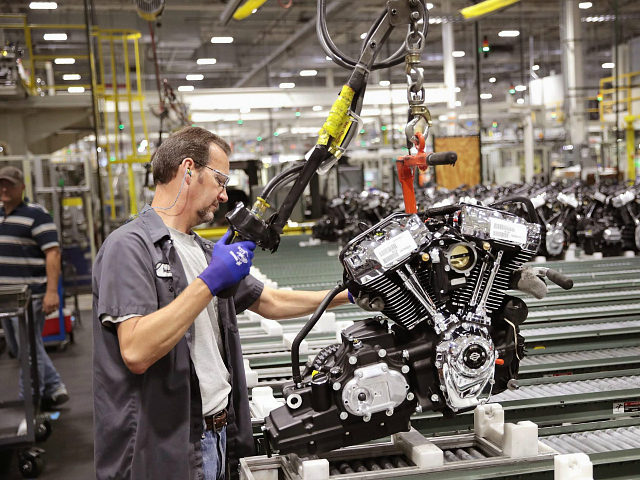Average wages rose sharply in 2019 in then-President Donald Trump’s go-go economy and also rose again in 2020 as China’s coronavirus pushed many lower-income people out of jobs, according to the left-leaning Economic Policy Institute (EPI).
The spikes reveal the Trump gains at the 2019 end of the EPI chart, released February 24 in the group’s annual “The State of Working America 2020 wages report.”
“Men at the middle and bottom of the wage distribution saw their wages rise in 2019: a 2.6% increase at the 50th percentile and a striking 5.7% increase at the 10th percentile, along with a 4.2% increase at the 20th percentile,” according to the organization’s 2019 yearly report, The State of Working America 2019.”
Wages rose rapidly during the 2020 coronavirus crash, in large part because many lower-wage workers lost their jobs and were pushed out of the annual wage calculations. The new report says:
Wages grew [in coronarivus year 2020] largely because more than 80% of the 9.6 million net jobs lost in 2020 were jobs held by wage earners in the bottom 25% of the wage distribution. The exit of 7.9 million low-wage workers from the workforce, coupled with the addition of 1.5 million jobs in the top half of the wage distribution, skewed average wages upward. [Emphasis added]
Pro-migration progressives control the EPI, so the reports typically ignore the wage-cutting impact of labor inflation caused by the arrival of millions of legal and illegal blue-collar and white-collar migrants.
But the group also provides much useful information about slow wage growth since 1990 when President George H.W. Bush and Sen. Ted Kennedy collaborated to double legal immigration and dramatically expand white-collar visa workers.
The inflated supply of workers, consumers, and renters helped employers pocket the huge gains from routine productivity increases. That economic transfer spiked the stock market for investors and also pushed many states toward Democrat dominance.
The EPI’s data echoes other reports.
“Families near the bottom of the income and wealth distributions generally continued to experience substantial gains in median and mean net worth between 2016 and 2019,” says a September 2020 report by the Federal Reserve banking system. The report, titled “Changes in U.S. Family Finances from 2016 to 2019: Evidence from the Survey of Consumer Finances,” said:
During the three years between the beginning of the 2016 and 2019 surveys, real gross domestic product grew at an annual rate of 2.5 percent, and the civilian unemployment rate fell from 5.0 percent to 3.8 percent.
…
Families at the top of the income and wealth distributions experienced very little, if any, growth in median and mean net worth between 2016 and 2019 after experiencing large gains between 2013 and 2016 [during the Obama administration].
The report notes that college graduates did poorly from 2016 to 2019. The family median income level of high school graduates rose by six percent, while the median or midpoint income of college graduates fell by two percent, according to the report.
The 2019 wage gains were also aided by raises in minimum wages in many states. The enforced wage gains did cut jobs because the economy was booming, and Trump largely blocked business demands for more legal immigration.
In January 2021, a construction industry CEO lamented that Trump’s deputies forced him to hire Americans instead of illegal aliens. Stan Marek, the owner of Marek Brothers, a Houston-based construction firm that has employed many illegal migrants, complained:
They were let go because of ICE [Immigration and Customs Enforcement] audits or Social Security No Matches, or insurance audits or whatever, and yet they’re 11 to 12 million people in this country on payrolls sending in about $6 to $7 billion a year of Social Security [payments] that they would never get. These ICE audits have taken millions of people off of payrolls and dumped them into the underground economy where they’re working for cash and not paying taxes.
In 2020, many business groups lined up behind Joe Biden partly because of his promise to dramatically accelerate the inflow of migrants in the United State’s consumer economy.
For years, a wide variety of pollsters have shown deep and broad opposition to labor migration and the inflow of temporary contract workers into jobs sought by young U.S. graduates.
The multiracial, cross-sex, non-racist, class-based, intra-Democratic, and solidarity-themed opposition to labor migration coexists with generally favorable personal feelings toward legal immigrants and toward immigration in theory — despite the media magnification of many skewed polls and articles that still push the 1950’s corporate “Nation of Immigrants” claim.
The deep public opposition is built on the widespread recognition that migration moves money from employees to employers, from families to investors, from young to old, from children to their parents, from homebuyers to real estate investors, and from the central states to the coastal states.
However, Biden’s officials have been broadcasting their desire to change border policies to help extract more migrants from Central America for the U.S. economy. On February 19, for example, deputies of DHS Secretary Alejandro Mayorkas posted a tweet offering support to migrants illegally working in the United States and to migrants who may wish to live in the United States.



COMMENTS
Please let us know if you're having issues with commenting.